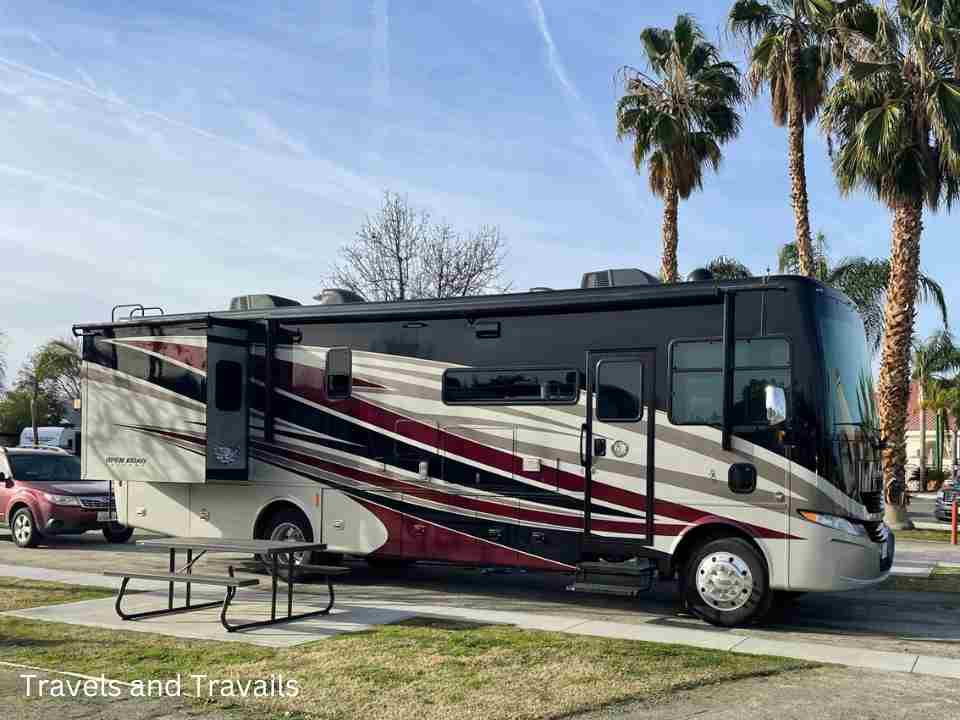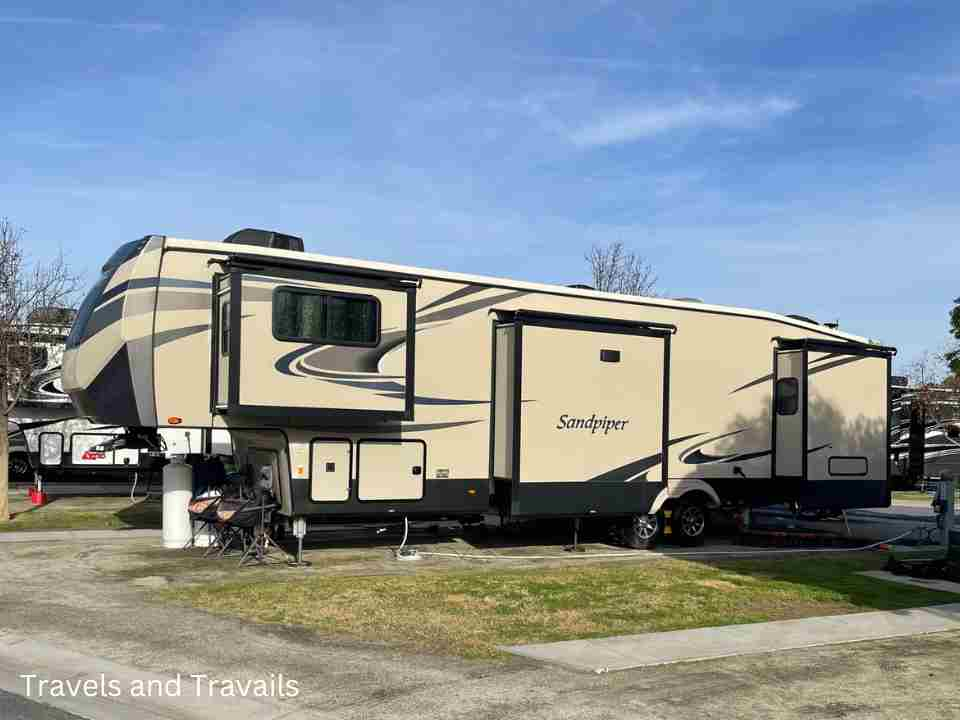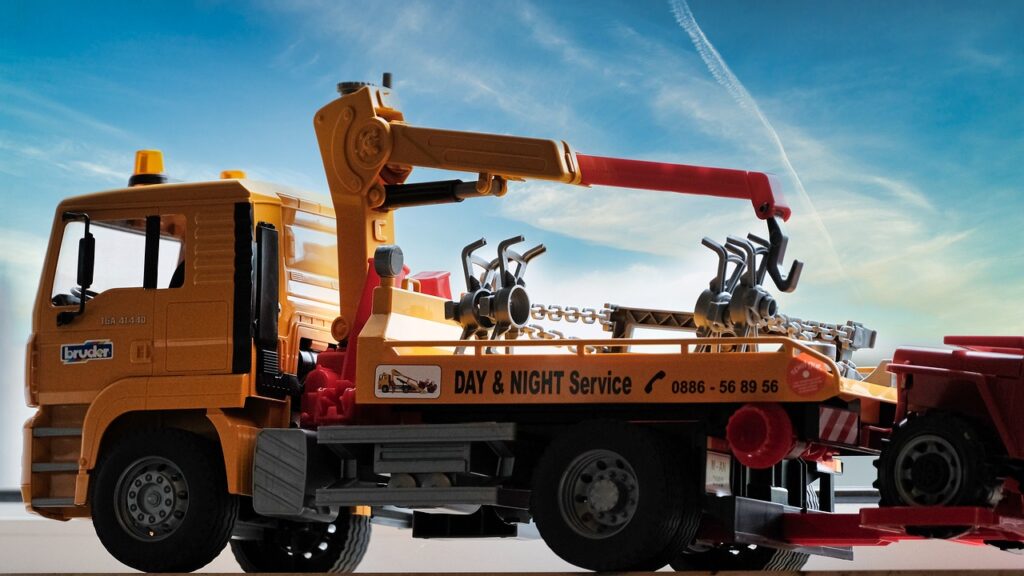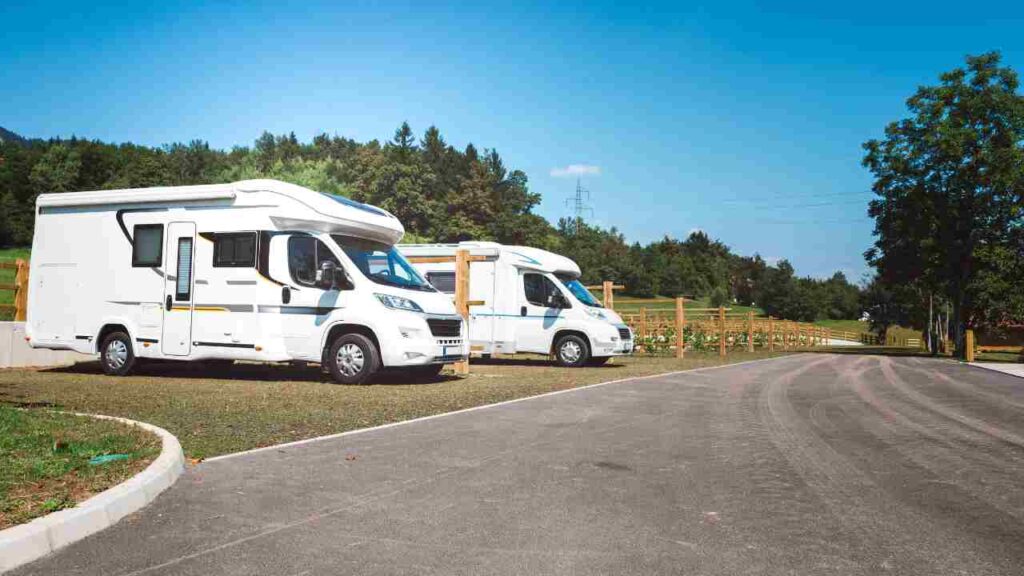You currently spend a few months of the year in your RV and then the rest at home. You enjoy motorhome living and long to do it more often, even full-time. You have yet to determine what kinds of costs you might incur, though. How much does it cost to live in an RV full-time?
Living full-time in an RV can cost anywhere from $1,000 to $5,000 a month, which is $12,000 to $60,000 a year. The average is between $2,500 and $2,800 a month or $30,000 to $33,600 a year.
Today’s in-depth breakdown of the costs of living full-time in a motorhome will help you decide if this monumental life decision makes sense. You’re not going to want to miss it, so keep reading!

How Much Will You Spend to Live in an RV Full-Time?
Let’s dive right in and further discuss the general costs of full-time RV living.
First, allow me to make one thing clear. There’s no one correct answer regarding how much you’ll spend to live in a motorhome per month and per year. It all depends on your comfort level, what you need, and where you stay on your travels.
The RVers who claim they spend only several hundred dollars a month to live in their motorhomes aren’t lying. Neither are the ones who say they do it for $1,000.
These people live rather frugal lives, pinching pennies and closely managing costs to stay within a set spending budget each month. That’s no different than how someone may live in a small home or choose a more minimalistic lifestyle to make ends meet.
On average, you should expect to spend between $2,500 and $2,800 a month living full-time in an RV.
That’s not a tremendous amount of money, at least not for most people. At this price point, you’re not living the most frugal RV lifestyle you could, but a comfortable one.
You’ve set aside enough cash for some luxuries (as full-time RV life has to make room for those), but you’re not splurging so much that you can barely afford to keep up with your own lifestyle.
If you want the best of the best that motorhome living offers, then plan to spend at least $5,000 a month to get it. At that price point, you might sometimes room in a cabin or yurt, and you’ll enjoy a greater number of amenities that make for a more enjoyable quality of life.
A Breakdown of All Your Monthly Costs When Living Full-Time in an RV
Even though full-time RV life will include pretty much the same components for everyone, the quality of the amenities makes a big difference in how much money you’ll spend month after month and year after year.
Here’s an overview of all the costs you’ll incur when living in your motorhome all year long.
Fuel

All motorhomes run on some fuel source, from propane to diesel or gas. The type of fuel source you use, your RV’s MPG, and the size of your gas tank will dictate what you pay at the pump.
Class A RVs generally use between six and 10 gallons of gas per mile, Class B RVs between 10 and 25 gallons, and Class C RVs between eight and 10 gallons of gas per mile.
If you spend about $21 for 50 miles or $210 for 500 miles, you can easily see how it can cost up to $300 or more to fill an entire motorhome gas tank.
Even if you only lived in your RV part-time or more seldom before and thought you were used to paying for high gas fees, the costs of paying at the pump when living in your vehicle full-time will be quite a jump.
There’s really no way to get around these costs except for spending weeks camping out at the same spot at a time.
I wouldn’t recommend buying cheap fuel, as that can impact how well your RV works!
RV Payments

Like you spend years paying off your house, you also have to pay off your motorhome.
The fees here vary too. Some RVers spend years saving up and then pay for the costs of their vehicle upfront. Others buy used and also pay upfront.
Others still will buy a new motorhome and pay for it little by little over time like you would with a new car or truck.
Even then, factors such as how much your RV originally cost, the monthly payment terms, and the rate of interest you’re paying on the vehicle will determine how much money you need to set aside for RV payments.
At the very least, you’ll probably spend about $225 a month here. That’s $2,700 per year.
On the higher end, you could spend $650 a month on your vehicle if you bought an expensive RV or if you have a lot of interest. You’d pay $7,800 a year on your vehicle until it’s paid off.
RV Insurance
While some RVers perceive insurance as optional, I’ve already written several posts discussing why that’s not the smartest idea.
You might think you’re saving money…until you get into an accident. It doesn’t even matter if you caused the accident or not. Without insurance, you’re on the hook for 100 percent of your RV repairs.
So what will you pay for motorhome insurance? The premiums cost anywhere from $200 to $3,000 a year.
You can always choose a cheaper insurance plan. You’ll save a lot of money upfront, but keep in mind that the insurance payoff in the event of an accident will rarely cover the entire cost of repairs or replacement.
This is when cheap insurance comes back to bite you, as you’ll shell out more money than you wanted to.
A more expansive plan will cost you more money per year, but you’ll have greater peace of mind that if the worst happens to your RV, you won’t be left to fend for yourself. Your insurance premium will kick in.
Health Insurance
What, you didn’t think that you no longer need health insurance just because you live full-time in your RV, did you? You certainly do!
You might decide for more expansive healthcare coverage now that you’re spending so much time in your motorhome, or you could stick with the same health insurance you’ve had all this time.
If you choose the latter, double-check that your insurance plan covers RVers. Not every health insurance plan does!
You might not even have to pay for your health insurance. Your employer could cover the full costs, but that depends on whether you still work for a company with your current lifestyle. If you did, it’d be in a remote capacity, of course.
If you’re self-employed, such as a graphic designer, photographer, videographer, or freelance writer, then you have to get your own health insurance.
Okay, so what will you pay for health insurance? At least $456 per person a month or $1,152 per family. Your yearly health insurance costs would be between $5,472 and $13,824 a year.
Roadside Assistance

Do you currently have RV roadside assistance? Now that you’ll live in your vehicle full-time, it doesn’t hurt to tack on this assistance to your motorhome insurance plan.
The cost of roadside assistance is $140 to $210 a year, so you’re hardly breaking the bank here. If anything, you’re enjoying even greater peace of mind, and putting a price on that is tough!
Mobile Internet
You might successfully forego Internet usage when camping out in your RV for a long weekend, but it’s a lot more different when you live in your vehicle all year. You can’t really skip the Internet then.
You have several options for staying connected no matter where your motorhome adventures take you.
You can get a cable or DSL setup via landline wires. You’d have service provider options like Frontier and AT&T, so you’d hardly work with an unknown company.
Although cable or DSL has an old-school vibe, you get relatively fast Internet, don’t incur data charges, and don’t pay too much for this service. The cost is $20 to $42 a month, which is $240 to $504 a year.
You can also use your smartphone’s cellular data. This wire-free option garners so much attention since it’s convenient. Just use your phone or tablet to connect to available Wi-Fi, and voila, you’ve got Internet.
To hem in your Internet usage, I’d recommend a data plan. Even still, you could pay $100 to $500 a month for cellular data. That’s $1,200 to $6,000 a year.
The third Internet option to explore is satellite Internet. You can choose between a tripod or a mounted satellite dish for your motorhome.
As the name implies, a mounted satellite dish attaches to your RV.
Tripod satellites have more flexibility, so you can adjust them for a better Internet connection the same way people used to adjust their satellite dishes for a better TV signal.
I’d also recommend a router receiver box with a satellite Internet option. This works like a standard household Wi-Fi router.
Satellite Internet costs the most of the options, as you could spend at least $300 for the dish alone (but likely around $5,000 or $6,000) and then another $200 to $500 to get a signal boost from the receiver box.
Your last option is to take advantage of free Wi-Fi as and when you come across it. Although you won’t spend any money to connect to the Internet, the connection only lasts for as long as you’re in the area.
You won’t be able to enjoy Internet when on the go like you would with most of these other options. Also, if you don’t know the password to a Wi-Fi hotspot, then unless you can procure it, you’re out of luck.
Phone Plan
Although you won’t get as consistent service once you live in your RV full-time, you still can’t stop paying for your phone plan.
Your phone will keep you current on what’s going on in the rest of the world, especially when you don’t have one stable home. The kids in your family will also need a phone as their lifeline for staying connected to their friends.
The standard monthly phone bill costs $127 a month, but that varies based on how many lines you have on the plan, which service provider you choose, and how much extra data you have.
At that price, you’d pay $1,524 a year for phone.
Medications

Do you take medication? What about your other family members? Although it’s harder to fulfill orders now that you’re always jetting around in your motorhome, you have to keep your prescriptions current even when living full-time in an RV.
Most Americans spend $1,200 a year on medications, according to a 2022 article from healthcare service Mira.
RV Maintenance/Repairs
You thought you maintained your RV before but wait until you start living in it full-time!
You’ll find that you have to maintain the parts more frequently and thus spend more cash on maintenance because your motorhome gets so much use.
That also means seeing a mechanic more often, as parts breakdowns will happen more frequently.
It’s tough to say what you’ll spend on maintenance and repairs, as it depends on the age of your RV and if your warranty covers any costs.
I recommend setting aside at least $200 a month for maintenance and repairs but possibly up to $800 a month. You’d pay around $2,400 and $9,600 a year.
Campground/Park Fees

You’re free to park your motorhome wherever you’re legally allowed to if you can track down free parking places such as truck stops, church parking lots, or the parking lots of some retail stores such as Cabela’s or Walmart, then more power to you.
Most RVers will find themselves staying at campgrounds or parks eventually. Unlike the other park options I listed above, staying at most campsites isn’t free.
You might have to pay a blanket fee, or you could be charged according to the type of vehicle or the amenities you want access to.
The prices start at $30 and can cost $50 to $80 or more. You could incur greater savings if you stay for longer, but that depends on the RV park or campground and if they offer discounted deals for extended stays.
Groceries
You’ve still gotta eat, and now that you’re living in your RV full-time, you’ll find that you’ll expand your culinary horizons beyond what you can cook over a roaring fire.
If you have motorhome appliances like a stovetop, oven, or microwave, you’ll use them more to enjoy nutritious, delicious meals even on the road.
GOBankingRates, with data from the U.S. Bureau of Labor Statistics, reports that in 2021, homes in the US spent $5,259 a year on groceries, which is $438 a month.
Of course, food prices increased dramatically between 2021 and 2022 and then again from 2022 to 2023, you can expect these costs to go up even more.
These prices just account for grocery bills. You might want to treat your family or partner to a nice dinner out every now and again, but those are additional costs. The grocery costs don’t account for any takeout meals you eat, either.
Tank Dumping Fees
Although dumping your graywater and blackwater tanks never gets easier, you become moderately desensitized to it once you live in your motorhome full-time since you dump so often.
Some dump stations don’t charge you, but I’d recommend getting into the habit of expecting to have to pay. You’ll spend $10 to $25 each time you dump.
If you dump your tanks every five days and a month has 30 days, then you’ll dump your blackwater and graywater tanks six times a month. That’s 72 times per year.
You’d shell out $60 to $150 a month for tank dumping and spend between $720 and $1,800 a year just to keep your tanks empty.
Laundry Fees

You still have to wash your clothes, but you don’t exactly have a washing machine and dryer in the vicinity to do it. You’ll instead have to rely on public laundromats as you come across them.
The cost of washing and drying per load starts at $2.50 and costs up to $10.
Entertainment
Your life on the road doesn’t have to be all about driving, driving, and more driving.
As I said before, you have to treat yourself and your loved ones to entertainment every now and again, be that trips to the movie theater, arcade, shopping, beach, or amusement park days, those kinds of activities.
Entertainment isn’t a low-cost expense, but it’s worth it. I suggest setting aside at least $1,000 a year for entertainment if you plan on keeping your outings relatively cheap.
For families that like more expensive entertainment, double or triple that budget.
How Do You Afford Full-Time RV Living?
You’ve decided to take the plunge and live in your RV full-time. So far, you’re really enjoying the freedom, but you wish it didn’t cost so much money.
Do you have any options to make motorhome living more affordable? You do indeed, so try these tips!
Budget, Budget, Budget
Just like you can’t successfully manage your finances when living in a home without a budget, you can’t do it in an RV, either.
You might not know how much you’ll spend initially, but once you’ve enjoyed your new lifestyle for several months, you can begin predicting expenses more accurately.
That makes it easier to create an attainable budget. It’s okay to splurge in certain areas, but if you’re trying to save, splurge only occasionally.
Eat Out Less
The costs of eating out can put a major wallop on your wallet.
Even if you’re only spending $10 per takeout meal, if you eat takeout four times a month, that’s $40 a month and $480 a year.
Think of what else you could use that $480 for. I understand that some days, after driving for 12 or more hours, you don’t want to cook, but you can always ask a housemate, family member, friend, or partner to help out and take over mealtime duties.
I’m not saying to eliminate the takeout from your life altogether if you don’t want to, just cut back. You will have more money in your pocket.
Don’t Let Your Gas Tank Get Empty
You’re not supposed to let your RV gas tank get too low anyway. Once you’re at 1/4th a tank, make it a habit to refuel, or do it even more frequently than that, such as at a half-tank of gas.
As I mentioned earlier, paying to fill your entire RV gas tank at once will cost you upwards of $300. You can halve that by refilling only half the tank.
Join an RV Club
RV clubs and associations have their advantages. Although you will have to pay more upfront, you can save in other ways, especially if you stay at a lot of campgrounds and parks throughout the country.
You might be able to enjoy free entry into campsites, and if not, you’ll have a discount that makes your stay much more affordable.
Look for Free Entertainment
You can also scale back what you pay for entertainment. I’m not recommending you forego entertainment but look for free options! Check websites and local newspapers when you roll into a city or town.
You should be able to track down some low-cost or no-cost things to do to entertain the whole family.
Conclusion
Living full-time in an RV offers you unparalleled freedoms, but you will spend quite a pretty penny to pull this lifestyle together. The average cost to live in a motorhome full-time is $2,500 a month.
You won’t have to worry about homeowner’s association fees, mortgages, sewer bills, community taxes, and the like, so you will end up saving money over the long run.
I hope the information in this guide helps you decide whether living full-time in an RV is a financially feasible decision!
